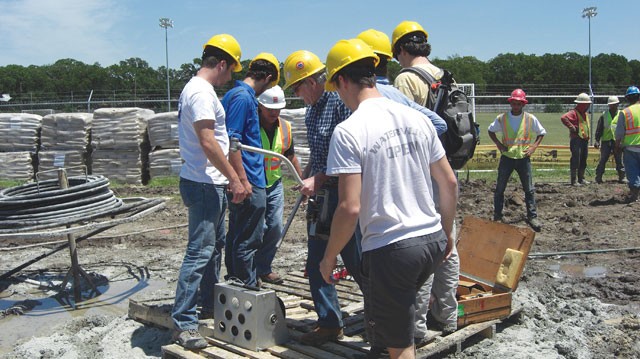
Two weeks ago, San Antonio resident Frank Smith signed a letter of intent to purchase an abandoned oil well in Brazoria County. But it’s not the oil he’s interested in; it’s the super-heated water at the bottom of the pipe that he hopes to run through a turbine on the surface, turning it into a reliable source of electricity to feed into Texas’ straining power grid. The well would take only a few months to set up, requires no toxic chemicals, and gives off no air pollution. Best of all, a researcher at one of the most prominent geothermal labs in the country thinks the technology Smith and a handful of others in Texas are investing in today could be rapidly duplicated at abandoned and closed oil wells across much of the state — ultimately providing enough energy to displace dozens of coal plants by 2050.
“I could never leave Texas and retire a billionaire,” boasts a confident Smith, owner of the SA-based clean-energy outfit Sologen. “But that’s not the goal. The goal is to seed an industry.”
The need for power in Texas was prominently on display last week, as triple-digit August temperatures and corresponding record-setting energy use hit the state hard day after sweat-soaked day. The operator of the bulk of the state’s power grid — the Electric Reliability Council of Texas — called for voluntary energy reductions between the peak-use hours of 3 p.m. and 7 p.m., and still we broke new state records three days in a row, topping out at more than 2,500 megawatts above last summer’s previous high of 65,776 megawatts. We would have broken the record again last Thursday if ERCOT hadn’t declared a Stage 2 emergency and called on industrial partners to shut down up to 1,000 megawatts of power to avoid rolling blackouts.
San Antonio-owned CPS Energy also encouraged conservation, tweeting last Thursday: “Here we go again... Heat continues to put strain on state electric grid. Conserve any way you can…”
While much of the electricity provided during the hottest times of the day is made by quick-firing natural gas, the bulk of power consumed in Texas is provided by coal. And even as state utilities struggle to meet the unprecedented demands of record-breaking temps and rising populations, coal power — indicted in everything from increased heart attacks, asthma cases, and weather-weirding climate change — is increasingly under assault. As the U.S. EPA continues to fight Texas over greenhouse gas emissions the state’s leadership refuses to regulate, new rules rolled out last month require fast reductions of soot and lung-damaging nitrogen oxides and sulfur dioxide — reductions that will inevitably lead to many older coal plants shuttering.
CPS Energy, already committed to closing down its oldest and dirtiest coal plant, JT Deely, years early, doesn’t expect to be able to meet the EPA’s deadline for bringing its next oldest coal plant, the Spruce 1, into compliance. In a letter to the EPA last fall, Angela Donaubauer Rodriguez, environmental and sustainability manager at CPS Energy, wrote the EPA that the lower limits for nitrogen oxides could not be met by Spruce 1. In a second letter, dated February 7, 2011, she wrote the new lower limits could be met, but not without “significant modifications,” and not by the EPA’s deadline of January 2012. And if coal is not a sure bet for future baseload power needs, neither is nuclear.
The utility’s push to double the South Texas Project nuclear complex was roughly buffeted by issues of high cost and lack of transparency among partners — but it was only iced when Japan’s multi-meltdown Fukushima disaster set the entire nuclear industry reeling.
Today CPS expects to meet future growth through the construction of new natural gas units and continued investment in renewables like solar. But until big strides are made in energy storage, the renewables won’t be able to do the city’s heavy lifting of raising our baseload power, the stuff that runs 24 hours a day no matter if the wind blows or the sun shines.
While Cris Eugster, CPS Energy’s chief sustainability officer, is hopeful that future research and development projects could make solar and wind (especially when paired with better energy management overall) more like reliable baseload energy, he recognizes it’s not there yet. And while geothermal has that coveted consistency on its side, it hasn’t been proven in the field. “It’s consistent from the get-go,” Eugster said, “but it’s not as far along as solar or wind. You can go to a wind farm right now, see it and feel it; you can’t do that with geothermal.”
For that reason, the handful of companies that have come calling in the hopes of securing commitments from CPS to buy their power (the way CPS committed to purchase 200 megawatts a year from the experimental “clean” coal plant to be built outside Odessa) have been turned away.
Smith, however, they’ll be watching with what could be called an interested detachment. Geothermal today is “almost like the venture capital world, and we’re not a venture capital firm,” said Eugster. “It’s very exciting technology, but really it’s something someone has to prove out there first.”
Smith is not your typical green-energy booster. He’s a businessman. An entrepreneur. He said he was inspired by former mayor Phil Hardberger’s unveiling of Mission Verde at 2009’s State of the City address, not for the chance to clean up the air, or do a good deed, but by the dollars involved. Considering the city’s newly launched sustainability program was calling for massive investment in energy efficiency and solar power, efforts now gaining muscle mass under the leadership of Mayor Julián Castro, Smith remembers thinking: “That’s $2 billion in work and you want to do that in how many years?”
Previously, Smith says he had moved between healthcare, pharmaceuticals, and computers. The “greenest” project he’d tackled before he calculated the potential profits involved in Hardberger’s vision was a propane-powered weed whacker. (Puffing on a cigar inside the Quarry Market’s Club Humidor, he pauses, an eyebrow cocked, as if asking “Perhaps you’ve heard of it?”)
If he’s trying to sell me on the solar side of his business, he’s doing a terrible job. “The problem with renewables, A-to-Z, is that they don’t work without subsidies and incentives,” he says. “And solar’s the worst,”
Yet, as long as the incentives are in place it’s a no-brainer. Smith says he recently installed a $200,000 system that ended up costing his client a mere $6,000 once all the federal, state, and local incentives and rebates were applied. The system today produces an average of $4,800 in energy every year. Talk about payback.
But it’s the heat of the earth — specifically a form of geothermal found across the Gulf Coast from Texas to Florida, geopressure — that has him most excited. Geopressure resources are typically found in deep salty aquifers trapped under enormous pressure. Either the steam or the heat of the water is used to drive turbine generators and create electricity. Smith plans to co-generate electricity at his site by also separating and using the methane found in the water.
And his project is worth watching, if for no other reason than because it’s been done before. None other than the U.S. Department of Energy tested a similar well in Brazoria County in the 1980s (Smith is close, but won’t say how close, to that original site) when the agency showed unequivocally that the heat of the earth from geopressure could be converted into electricity. In that investigation, part of a larger DOE campaign begun in the 1970s fueled by national interest in reducing dependence on Middle East oil, operators generated a single megawatt of electricity over six months from both the super-heated water and the natural gas captured and separated from the water. While the electricity couldn’t compete with coal at the time in terms of cost, the project also showed that geopressure could serve as a sustained energy resource: The well was flow-tested over five years, according to Maria Richards, researcher and lab coordinator at Southern Methodist University’s Geothermal Laboratory, without any significant reduction in flow. “They were able to prove that it is a lasting source,” she said.
In the years since the DOE project, called Pleasant Bayou #2, two things have happened that suggest geothermal may be ready for commercialization in Texas. First, the technology has advanced to the point that even lower-temperature waters in the 100- to 300-degree range (which is most of the state’s geothermal capacity) can be effectively used. Second, researchers have mapped out geothermal’s presence across the state, taking much of the guesswork out of the process of deciding where to drill or which wells to re-enter.
While solitary geothermal wells tend to generate a relatively small amount of power, Richards envisions geothermal wells taking over abandoned oil and gas fields the way a field of wind turbines covers a landscape, collectively producing a traditional power plant’s load of continuous energy. In that way, she sees the technology displacing coal plants in the decades ahead. “That’s the neat thing about geothermal: It is baseload. It can be something that can be scaled up. It can really compete with a coal plant,” Richards said.
But even as she says it, she hesitates. “For the most part, geothermal is going to start out small, like a wind turbine. Where you have a field of oil and gas wells, there’s no reason not to expect that in the future that field could be turned into a heat-exchange mechanism.”
Even active drilling operations could reroute what drillers typically view as wastewater through a turbine to make energy as they drill. Because of the heavy mineral content, state law requires the groundwater to be reinjected beneath the surface as waste, but at least one driller in Mississippi has already tapped into the non-traditional revenue stream, Richards said.
Geothermal’s “plus” column grows long in a report for the DOE by an MIT-assembled panel in 2005. “Because EGS [Enhanced Geothermal Systems] plants have a small footprint and can operate essentially emissions-free,” the team wrote, “the overall environmental impact of EGS power facilities is likely to be positive, reducing the growth of greenhouse gas emissions while providing a reliable and safe source of electricity.”
With 3,100 installed geothermal megawatts being generated in the U.S. annually, there are still no commercial operations in Texas. Still, Richards is optimistic, saying she expects to see the state generating “hundreds of megawatts” in the next few years and “tens of thousands” of megawatts by 2050. Smith, by comparison, is absolutely bullish. He sees the potential for geothermal to meet a full half of all the state’s power needs. And he says he’ll be able to sell it in a matter for months for less than nine cents a kilowatt-hour (more than coal, if you don’t factor in the cost of building the coal plant, but less than solar). Though he’s still pursuing subsidies, he insists he can make a profit without them.
Richards hopes more traditional oil and gas companies will get involved. “They have a lot of the technology already, they have a lot of understanding of the earth. For them it is more of a slam-dunk than for someone coming from wind or solar or wanting to invest in something new.”
Russel E. Smith, executive director of the Texas Renewable Energy Industries Association, said geothermal and other renewables could be slowed by massive federal spending cuts on the way. “I’m afraid there will be definitely some stalling. But, you know, economics and politics have a way of changing on a dime. You never know what’s going to happen next.”
If anything, the dire economic conditions offer Frank Smith and Sologen the perfect opportunity to prove his claims under less-than-ideal conditions. Speaking from the road to Houston on Tuesday, he said he’d be producing electricity at his first 2.5-megawatt well in about four months. He plans to rapidly duplicate the process at 400 of 5,000 abandoned oil and gas wells his team found usable along the Gulf Coast’s geopressure zone to produce more than a gigawatt of energy within six years — or one and a half times the power of a typical coal plant.
“At the end of the day, we become the insurance policy to the oil and gas industry,” Frank Smith said. “Rather than spending potentially $100,000 to plug a well, they may turn it over to us and we convert it. Once this actually takes off and we become known in the industry, it really becomes transformative.” •

















